Between 1984 and 1987, I made a few test transmissions with this system from Bolton, and had a few QSOs from the G8CXH club station in Bristol.
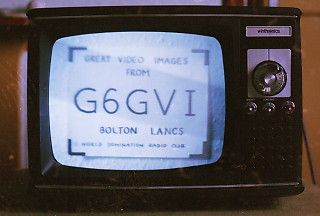
| My first ATV transmission was on 70cm in 1984. The video source was an old Hitachi surveillance camera, which produced rather smeary black-and-white images. The video signal was simply amplitude-modulated onto a 70cm PA (driven with my FT708 handie), and a co-ax filter restricted the bandwidth of the transmission (converting it into a vestigial sideband signal). My receiver was a Wood & Douglas kit, which up-converted the signal for viewing on a domestic TV receiver. 2m FM was used for sound and talkback.
Between 1984 and 1987, I made a few test transmissions with this system from Bolton, and had a few QSOs from the G8CXH club station in Bristol. |
 |
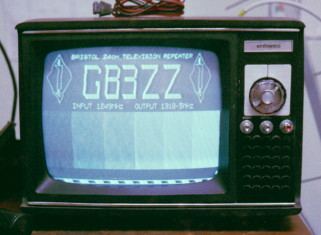 |
A neighbour had given me their old satellite receive equipment, and I wondered if I could re-use this in the amateur bands. Living in Bristol, I was fortunate to have two ATV repeaters (GB3ZZ on 23cm & GB3XG on 3cm) within range, so I set to work.
Analogue satellite set-top boxes are actually FM television receivers which tune 1-2GHz, so it didn't take much work (mainly the addition of a pre-amp and an antenna) to be able to pick up GB3ZZ on 1316MHz. With a lot more fiddling, I was able to convert the LNB to receive in the 10GHz band (rather than the 12GHz DBS band), and this allowed me to downconvert and tune in GB3XG too. |
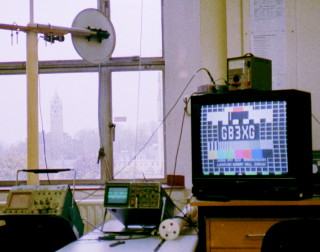 |
Once I was able to pick up the test-cards from the repeaters, it was just a matter of waiting for a "live" signal to appear. Then I was able to watch the transmissions from G1HIA and others, and even talk back to them on 2m. Soon I wanted to be able to join in the fun by sending my own pictures, so I converted an old PW EXE 10GHz FM voice transmitter for wide-band video signals. Even with only 10mW from a Gunn-diode, the EXE dish gave me sufficient ERP to put a strong signal into GB3XG, some 5 miles away.
My first transmissions used the same old Hitachi surveillance camera, but I soon acquired a Canon colour 8mm camcorder to use as a video source (this had the additional advantage that I could send pre-recorded video clips, and it also had a built-in caption generator). Soon my transmitter had 6MHz FM sound too.
At that time, I was unique in having full ATV capability on 3cm, but being unable to transmit on the much more popular 23cm band, so I set about building one of the BATC transmitter kits, and then had 1.5W out on 1250MHz too.
I had a lot of fun with this equipment, both operating through the repeaters in Bristol, and also with direct (simplex) contacts across town and from the local hills. Sometimes we used the two repeaters in tandem, to give a full two-way "video-conference" facility.
The help and encouragement of members of the Severnside ATV Group was invaluable in getting me going on ATV, and I was privileged to serve as their Chairman in 1999/2000. I was also fortunate in having access to the facilities of the Communications Research Laboratory at the University of Bristol, from where I made several demo transmissions on Wednesday afternoons when prospective students were being shown around, and we had our video link running during Open Days too.
| In June 1997, Bristol was celebrating the 500th anniversary of John Cabot's voyage across the Atlantic, and local amateurs had set up Special Event Station GB0CT from the Cabot Tower on Brandon Hill (they were operating mainly on 20m, but kindly let me operate under their call when I turned up with my ATV gear). The Tower is a popular landmark which contains a spiral staircase up to a windswept viewing gallery at the top, from where I set up my 3cm transmitter and dish, and beamed live pictures and sound across the City to G1HIA at Horfield. Phil was talking back to me on 2m FM, which helped me to point my dish accurately at him.
This was one of a number of outside broadcasts which I made from high spots around Bristol in the late 1990s. |
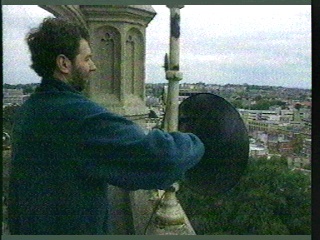 |
As a member of the Severnside Television Group, I took part in a few of the BATC ATV Contests. These events are held over a weekend in mid-September, and run for 18 hours. STG always put on a competitive station (G7ATV/P), from a caravan on the top of the Mendip Hills in Somerset. In 1998, we had a huge array of aerials for 70cm, 23cm 13cm and 3cm on the top of a 60ft crank-up tower - it had to be seen to be believed!.
I also went out as a one-man portable station, giving the club points for contacts on 23, 13 and 3cm from some distant hill.
My first transmissions on this band used the unlikely combination of a laboratory signal generator and a 500mW PA from a student project, but I eventually built up my own transmitter and receive converter, and a 1W amplifier kit from DL2AM. We often used 13 and 23cm as a 2-way duplex TV link between local stations in Bristol.
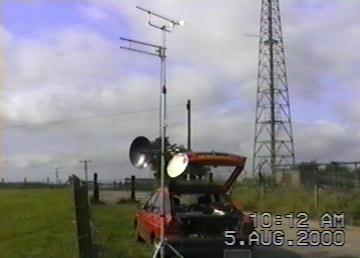 |
In 2000, while serving as the STG Chairman, I set up a
Millennium Trophy event to encourage ATV operation, and had a friendly rivalry with
Phil G1HIA to see who could make the most portable QSOs on all three bands during the year (we managed a total of nearly 80 QSOs between us!).
I used the following equipment for portable ATV: a Canon camcorder, with either its internal or an external tie-clip microphone; a modified FM-TV tuner from a Philips satellite unit; a BATC 23cm TX kit, with an external 15W PA/pre-amp if required, and a Jaybeam 15+15 slot-fed yagi; a 13cm TX based on a Mini-Circuits VCO, with a DL2AM 1W PA, and the antenna was a home-built 18-ele loop yagi; my 3cm kit comprised a modified PW EXE Gunn-diode transmitter with penny-feed dish, and a seprarate dish with modified LNB for receive. The picture shows this kit being used to exchange signals on all three bands between the Mendips and Walbury Hill, Berkshire (an 88km path). |
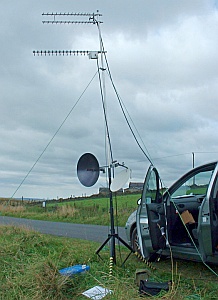
I still have all of the kit which I used back in 2000 (still in working order), and my interest in ATV has been re-awakened, so listen out on 144.75 and watch out for my pictures from Winter Hill over the summer of 2007.
We had the Bolton Wireless Club active on ATV and I operated portable from Winter Hill in both of the BATC contests of 2009.
In the September event I was assisted by Bob M1NUS, and gave Daniel M0OTE his first-ever 2-way ATV QSO.
More details of the simple equipment I've used for ATV can be found here.